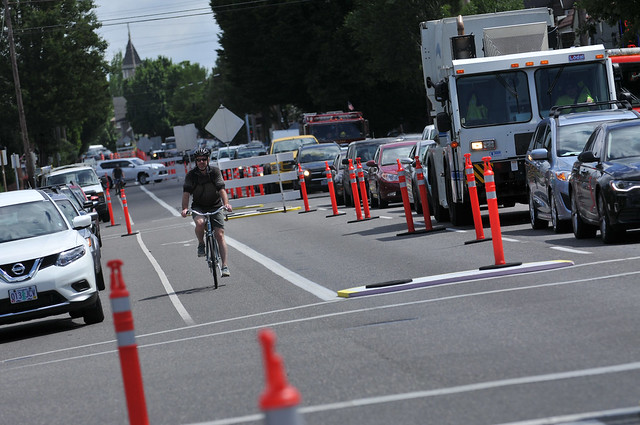
(Photos: J. Maus/BikePortland)
The gutsiest tactical urbanism project Portland has ever seen is officially underway.
“The corridor is so wide the potential is really untapped. We have so much historic character along the street, but it’s drowned out by three lanes of traffic.”
— Steve Cole, president of the Irvington Community Association
Last night nearly four dozen volunteers transformed Northeast Broadway for about a mile between 24th and 7th by adding 12 new crosswalks, median islands and a protected bike lane. It’s all part of the “Better Broadway” project spearheaded by Better Block PDX and a host of other community and advocacy groups in close partnership with the Portland Bureau of Transportation.
The goal of the project is to “turn a mean street into a main street,” organizers say, by changing the configuration of Broadway from an auto-centric thoroughfare to a more enjoyable environment where shoppers, bikers, and walkers have more room to breathe.
I rode in the new lane this morning and it was indeed much-improved. Instead of a door-zone on my right and fast auto traffic on my left, I meandered and window-shopped as I rode down the street. And because of the narrower roadway and new crosswalks, people are driving much slower.
Broadway’s old cross-section was the classic urban arterial: six lanes with two on-street auto parking lanes, three standard lanes, and a standard bike lane. As of this morning Broadway still has six lanes, but only two of them are standard vehicle lanes. There’s now a larger protected bike lane and a curbside lane that’s open for cafe tables and walking. One auto parking lane remains the same and the other was supposed to be “floating” to act as a buffer between moving auto traffic and the bike lane, but that feature wasn’t ready as of this morning (organizers are planning to tweak the design a bit more tonight).
At a launch event this morning we heard from Better Block, the Broadway-Weidler Alliance and other project partners. Kathryn Doherty-Chapman with Go Lloyd (a group that promotes biking, walking and transit in the Lloyd District) said stores and restaurants on the north side of the street (closest to residential neighborhoods) get twice the business of the south side simply because people don’t like to cross the street. Doherty-Chapman said her hope is that the Better Broadway project creates conditions, “Where crossing the street doesn’t feel like a life or death choice.”
Commissioner Steve Novick’s Transportation Policy Advisor Timur Ender spoke in front of a temporary floating bus island at NE 16th — the first ever in Portland. Volunteers have laid down an ADA-compliant curb ramb near the existing curbside bus stop that goes into a new crosswalk. The crosswalk leads bus riders up onto a wooden platform where they wait for the bus. This allows the bus operator to service the stop without having to drive across the bikeway (this is the design the city wanted on North Williams). “This was a risk for TriMet,” Ender said. “But they went along with it.”
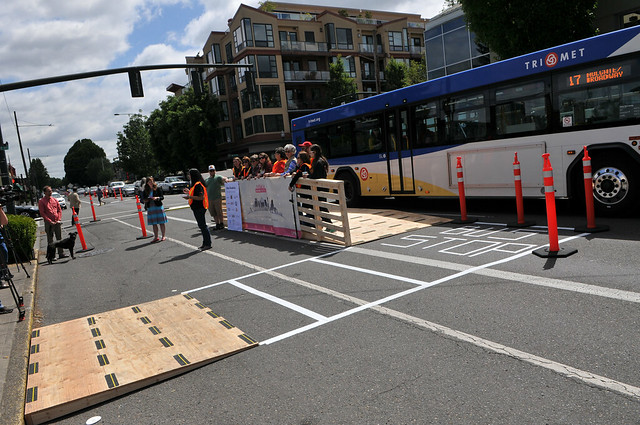
Ender, a former volunteer with Better Block PDX, spoke about the spirit of the project. “Our streets are made with concrete and stone, but they don’t have to be set in stone.” This willingness to take risks and try new things on our streets is at the core of these “Better” projects.
Ray and Nancy Tanner agree. They were at the event as volunteers with the Oregon chapter of AARP. “Some things you just need to try out,” they told me during a walking tour of the project prior to the press conference. “The more heads you get together, the more ideas you get. The city planners don’t always have the best answers.” Ray Tanner, who walks with crutches on both arms said projects usually just meet the minimum ADA requirements. “But those are just minimums! This project challenges the minimums.”
Steve Cole, president of the Irvington Community Association is also happy to see the project. “In the long-term, we’d like to see Broadway right-sized. This used to be a de-facto highway,” he continued as people drove slowly and traffic backed up on the street. “We’d like to see this as a destination for tourists. The corridor is so wide the potential is really untapped. We have so much historic character along the street, but it’s drowned out by three lanes of traffic.”
At around noon that traffic had come to a standstill and was backed-up for several blocks.
As of this morning project organizers said they still had several tweaks they need to make. The intention was to have the northside parking lane “floating” in the street and acting as a buffer between moving auto traffic and the bikeway. A press release for the project promised a “street fair” atmosphere for the entire week where there would be, “outdoor seating, music, activities, art, and more.” But the temporary striping and signage isn’t robust enough so people are still parking curbside. This means more bikeway blockage and businesses aren’t able to put their tables and chairs in the former parking lane. As of this morning only three businesses had taken advantage of the curbside space.
Advertisement

Another goal of the project is to avoid traffic jams. Today at around noon people in cars were backed-up for several blocks. This encouraged unpredictable turns (people bailing on Broadway and opting for neighborhood streets instead) and other dangerous behaviors — not to mention that there’s a risk that congestion will be the image that captures most of the media and public attention.
“It’s just ludicrous… You’ve already got a bike lane. What more do bicyclists need? A pedicure on every corner? Massage tables?”
— John Olson, local resident
John Olson lives a few blocks away. He couldn’t believe his eyes. “This is a completely ill-conceived idea,” he told me during an interview. Olson thinks having two standard vehicle lanes instead of three is a “cockamamie” idea. “Traffic in Portland is awful, I don’t see how this makes it any better. It’s just ludicrous on the face of it.” Olson told me he bikes and walks in the neighborhood and would love for Broadway to be more like Mississippi or Alberta (thriving commercial corridors with narrow, two-way streets). I asked him why he wouldn’t want his own neighborhood street to feel as comfortable and walkable as those. “This just isn’t like those streets, they were naturally like that. Broadway was built like this for a reason. There’s a lot of traffic studies that went on to put three lanes here. And now, with traffic getting worse, we’re just going to do a complete 180? Look at this! It’s backed up and this is noon, imagine what this will look like in the morning!”
When I pointed out that maybe a reconfigured Broadway would encourage people to drive less, he scoffed at that idea. “Until you can rip people out of their cars – probably by force,” he said, “You’re talking about social engineering.” “Forcing people out of their cars is a concept I generally agree with, but still… What are we going to do, get rid of I-5 too? Things need to move man! This is just going to create more problems than it will address.”
As for making the bikeway safer and more appealing to more people, Olson said (with a smile), “You’ve already got a bike lane, what more do bicyclists need? A pedicure on every corner? Massage tables?”
Is Better Broadway what you need? Give it a ride next time you’re in the neighborhood and let us know what you think.
— Jonathan Maus, (503) 706-8804 – jonathan@bikeportland.org
Our work is supported by subscribers. Please become one today.



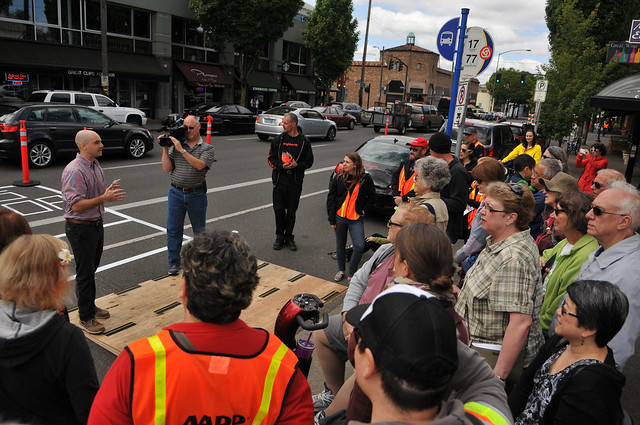

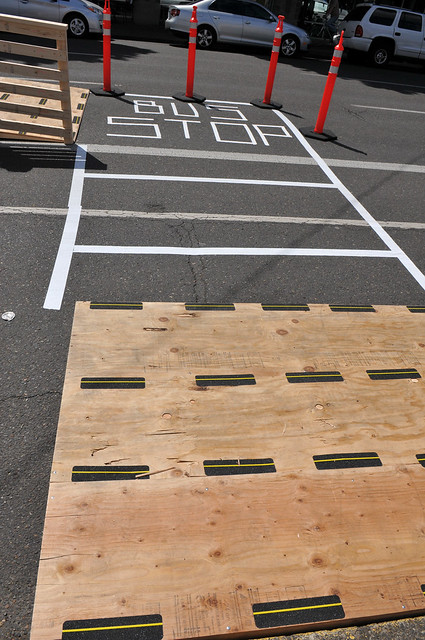

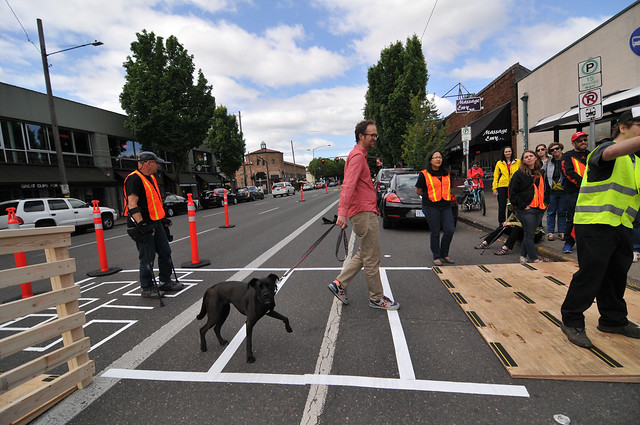
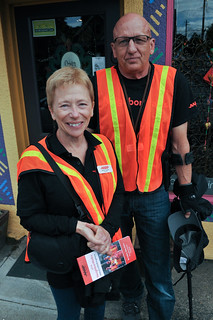
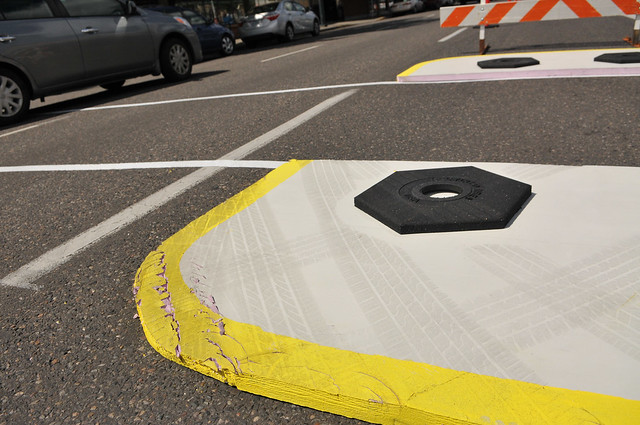
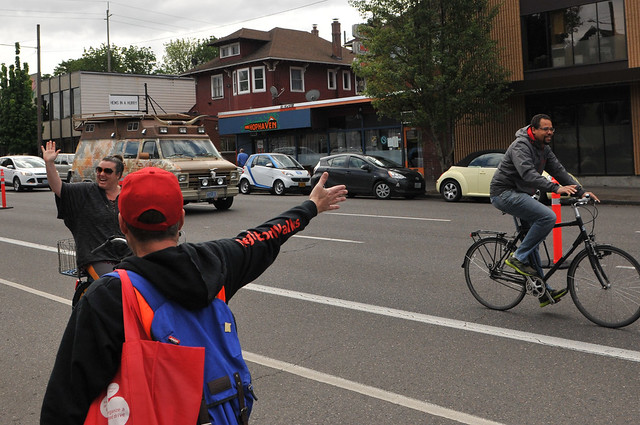
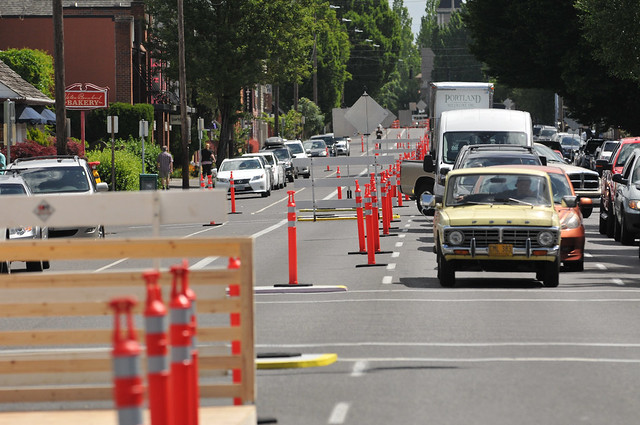
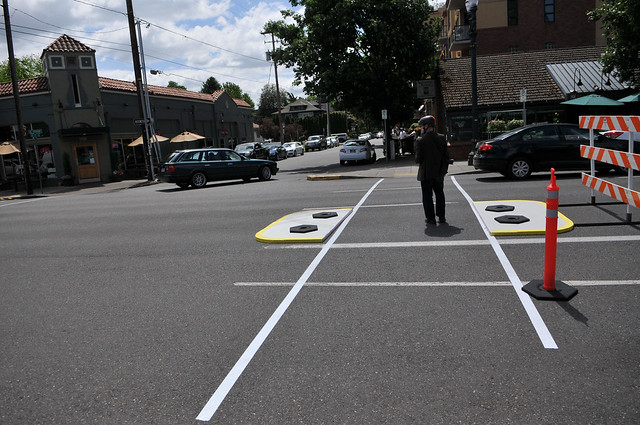

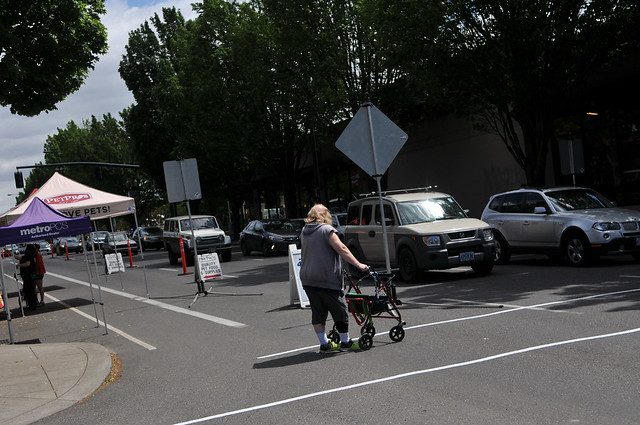
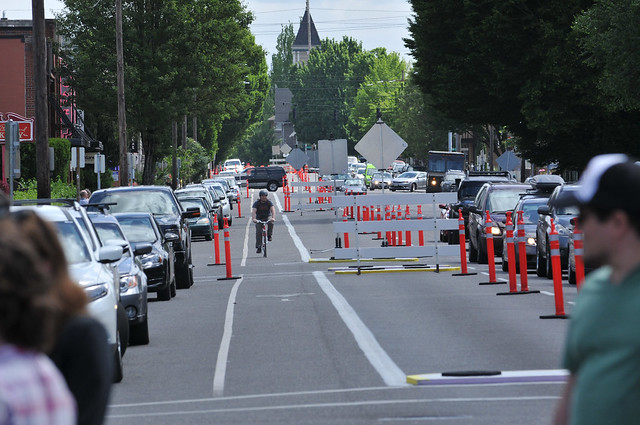
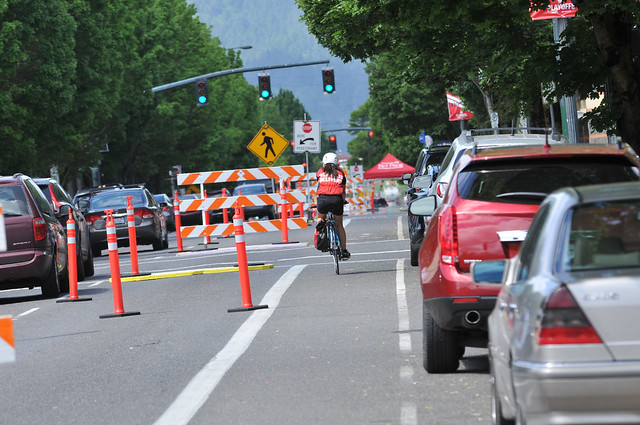

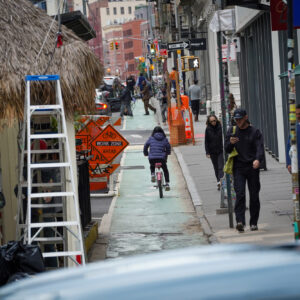
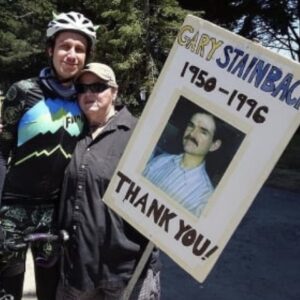
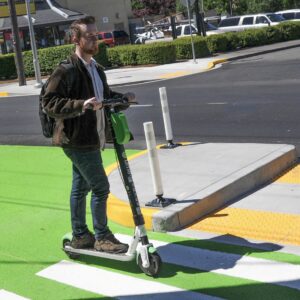
Thanks for reading.
BikePortland has served this community with independent community journalism since 2005. We rely on subscriptions from readers like you to survive. Your financial support is vital in keeping this valuable resource alive and well.
Please subscribe today to strengthen and expand our work.
Perfect “man on the street”.
“Social Engineering” appears to be the new buzz phrase. “Oooooh…..social engineering…..watch out!”
It’s not new, and as a certified PE in Social Engineering, I should know.
Same with “War on Cars” and “Agenda 21”.
D,
The irony, of course, is that most people that use the term use it to only describe the thing they dislike, ignoring that past choices were made that achieved what is being proposed to be changed. In effect, the person that complains the new thing is ‘social engineering’ ignores the fact that the current thing is also ‘social engineering’, the only difference being they are used to what they have and uncomfortable with change.
Right. People were pretty comfortable with things like horses, streetcars, and, oh, other people populating the streets. Then, came the cars…
Is this the time to mention that pedicures and massage tables sound great?
John Olson is a visionary.
Some people are concerned that 2 car lanes on Broadwy between24th and 15th should remember that same stretch of Wedler has only had 2 lanes for a long time.
Also, I’ve definitely seen traffic backed up for blocks on Broadway at noon on a weekday with four lanes of traffic.
Could it be that the 4 lanes are one of the reasons there are so many cars there?
Wait, why is the curbside parking still there? That’s going away, right?
Also, why is the goal to “avoid traffic jams”? That sounds like it’s straight out of ODOT’s mouth. We want congestion as it serves as a deterrent to driving.
It also deters transit use when you fail to provide sufficient priority to buses and trains. Our region is perpetually stuck at 10-12 percent transit mode share for years and lack of travel time competitiveness with driving may be a factor.
That’s why you remove half of the car lanes and replace them with dedicated transitways. Either sit in your car stuck in endless traffic or take the bus/train that runs traffic-free without delay. Your choice. 😉
Exactly, Adam! I just finished a long paper that I’ll be sending to the stalled Powell-Division project’s steering committee (http://bikeportland.org/2016/03/18/rapid-bus-plan-on-powell-division-stalls-after-it-turns-out-not-to-be-rapid-178130). In the paper I go on for over *20 pages* about exactly why median-aligned *real* BRT (think MAX on rubber tires) is needed for every single block of inner Powell and outer Division, along with the dozens of ways it will benefit ALL people, including those who drive. Most importantly, though, it will reverse *decades* of incredibly poor planning in East Portland.
Regarding this *awesome* Better Broadway project, it will take time (much more than the pilot project’s length) for drivers to adjust. Plus, like DaveB said, Weidler has been 2 lanes one-way for a very long time. So, I don’t at ALL buy the argument that Broadway “needs” three full (and WIDE) lanes one-way. It was designed to be driven like 60 mph! Plus, Janette Sadik-Khan famously says, “Cities are not building their way out of congestion. They are building how many lanes of congestion they will have.”
Also, think of this project from the drivers’ perspective. For many, many years until just now, they’ve had three super wide lanes, PLUS parking, plus a lame striped bike lane that they either ignore or can use as even more road space. So, of *course* they’ve gotten used to using the street as much as possible; it naturally fills up because it’s literally a wider (and certainly straighter) west-bound option than the Banfield!
But now all they can see are hundreds of plastic bollard, cones, wooden installations and other weird obstructions. Once this becomes *permanent*, though, all those temporary features will be replaced with much visually (and literally) cleaner concrete barriers, etc. It will be an entirely redesigned road, and within 2-3 years, NO ONE will want NE Braodway to go back to the way it was, *especially* the happy store/restaurant/etc owners whose business has gone way up and who’ve put out beautiful, permanent seating, parklets and other amenities.
For now, the best way to show that it works is to, like some have said, have a literal party on the street! 🙂 Show folks that *streets* are for PEOPLE!!
Roads are for getting people quickly from one area to another (think I-5 *outside* of the metro area, i.e., if you’re heading to Eugene). Streets are, like Chuck Marohn of Strong Towns says, “platforms for creating wealth.” Chuck Marohn also calls most of our urban historic highways (Powell, Barbur, 82nd, etc) “stroads” – the “futons” of traffic engineering. Stroads function *terribly* as both streets AND roads. It’s time to convert the NE Broadway stroad into an actual STREET that benefits the entire surrounding area!
I totally agree with you! This is why I think it’s very important to get these temporary projects right. If the goal is to show everyone that the sky won’t fall if a car lane is converted into a protected bike lane, transitway, plaza, etc. then let’s show them something as close to the ideal as possible and something that accurately describes what the permanent solution would be. If it’s not done right, people won’t be able to see the benefits. Saying “we’ll fix it in the permanent solution” will convince no one.
If you “avoid traffic jams” to make buses run faster*, how does that make buses more competitive on travel time? Roughly speaking**, if your drive is delayed by 10 minutes, your bus is delayed by 10 minutes. If your drive isn’t delayed, your bus isn’t delayed either- so buses still appear as good (or bad) as before.
* because honestly, MAX is another matter, much less conflict with traffic, except gridlock.
** roughly speaking, because ratios change and there are contrived examples that would fit on either end of a bell curve.
See my above comment. 😉
I owe you a coke.
yeah I’ve cringed a bit when project organizers talk like that. I think they’re trying to say that the street has so much excess capacity that redesigns like this can happen with little to no impact on driving times.
Yeah, I agree. Perhaps they should have phrased it the way you did. 🙂
Lots of cars sitting idling….that’s a good thing?
Mr. 0lsen,
I think we better be ripping people out of their cars if we want our Children and Grandchildren to have a planet to live on. How are we going to deal with cutting c02 emissions as rapidly as we need to if we can’t even get get rid of one lane of traffic on Broadway?
Don’t worry, self-driving cars will totally solve all of our problems! 😉
You’ll have to rip them out of their apartments too –
Commercial and residential buildings account for almost 40% of yearly carbon emissions, vs. just under 30% created by cars (2011).
http://www.eesi.org/files/climate.pdf
https://www3.epa.gov/otaq/climate/documents/420f13033a.pdf
As they say in real estate, location matters. Sure, nationally buildings are bigger emitters than transportation, but the national grids involve much more coal, oil and natural gas generated electricity than the grid in Oregon. We’ve got so much hydro and wind that transportation is our biggest source of climate changing emissions.
And around 95 megawatts of solar on deck for eastern and central Oregon.
Per capita, it’s a more meaningful comparison (if not the only meaningful one) when you compare greenhouse gas emissions among different types of uses. Of course bigger buildings emit more carbon, but they also serve way more people. Single family homes have a much higher carbon footprint per capita that large commercial and residential buildings.
Commuting and single occupancy vehicle travel represent a relatively small fraction of the CO2e generated in the USA:
http://pubs.acs.org/doi/pdf/10.1021/es400399h
And yet it remains responsible for nearly all the CO2 generated by moving people from A to B…
if we are going to make progress in addressing climate change an evidence-based approach is essential.
Oh I totally agree and as someone who passionately tries to resist using fossil fuels for simply transporting an incredibly mobile species I still realize other industries are the larger culprits… Every bit helps though, even if just in helping spread the mindset of reducing resource abuse to other sectors.
It’s a tough balance to focus energy on reducing oil use while not getting comfortable and thinking “I did my part” simple because you reduce the car trips you take.
Depends on how you define “relatively small.”
We’ll need to address almost all sectors if we’re going to get to an 80% reduction.
Transportation is 26% of the U.S. global warming pollution.
https://www3.epa.gov/climatechange/ghgemissions/sources.html
Transportation is about 37% of Oregon’s global warming pollution. http://www.oregon.gov/DEQ/AQ/Pages/Greenhouse-Gas-Inventory-Report.aspx
Now, commuting is a subset of that, and single car travel is a larger subset, but what we do with the streets tends to impact the freight component, and how we invest our dollars impacts the air travel part of it.
i see little interest among mainstream oregon advocates or elected officials in addressing all sectors. dietary or housing choices are rarely given serious attention and there is absolutely no sense of urgency when it comes to energy generation.
“said stores and restaurants on the north side of the street (closest to residential neighborhoods) get twice the business of the south side simply because people don’t like to cross the street.”
Wow! Is this a fact or an approximation? Because if it’s literally twice the business, that would be very handy information to have.
Thanks to all of the people who put in late hours to make this happen. I used Better Naito today for an errand into downtown and so enjoyed it. Can’t wait to experience Better Broadway!
Better Naito was so much better today without all the trucks!
pedicure / dooring… same diff yep.
Between Jonathan calling a door-zone bike lane a standard bike lane (typical, yes, but not standard) and that “man on the street” dismissing the need to improve such a failed implementation I almost gave up hope.
I received similar comments when I worked to remove parking on a street in my neighborhood so we could resolve the door-zone bike lane issue. However, I had 92% of the residents backing me, so we got the parking removed. Unfortunately, even after we got rid of the parking, the city traffic engineer, later found to be unlicensed, broke his promise and widened the travel lanes so that one of the bike lanes remained in the door zone. I guess it was a half-win.
I live at NE 20th and Broadway. I usually opt to ride on NE Tillamook St. to cross the Broadway Bridge on my way to work downtown every day as it’s much less stressful than dealing Broadway/Weidler traffic.
But I gave riding on NE Broadway a shot this morning, and to be honest, I really didn’t enjoy it. Drivers on NE Broadway turning right onto side streets seemed super confused, and I almost got right hooked 2 times within 15 blocks (which is worse than normal).
While it has a similar feel to riding on Multnomah, I think having few lights on NE Broadway just makes it tougher to navigate. Guessing it’s also because due to the wide width of the bike lane, drivers have a harder time using mirrors to check for cyclists before turning right.
As you mentioned, there are still cars parked on the north side of the street, which led to some confusing situations as well.
I understand this is a pilot project, and I really like the idea behind it. But I feel like more needs to be done to educate everyone about what’s going on and how to move through this section of road.
It was the first day of the pilot program. I am sure many drivers were confused by all of the cones on the street. I bet many of these issues would be reduced if it became a permanent design, with paint instead of cones.
Right, because drivers are great at honoring bike lanes that have been there for a substantial amount of time.
I do think it would be better than the confusion associated with the first day of this program.
It seems when cones emphasize the lines that are already there they work great, but when the cones don’t match the lines it is bound to create some confusion
I have to agree that just based on the pictures it doesn’t seem like a relaxed setup to bike in. All the cones makes it feel like a construction zone where everyone is on edge about exactly how to navigate the new setup. Long term I think it is feasible but I just don’t like the idea of using cones, as a cyclist. Perhaps they tried to do too much for just the one week. Could they have instead made the parking lane the bike lane and use the existing bike lane as a buffer / bus loading zone while still doing the crosswalk improvements? It seems removing a travel lane and hoping business would use the parking lane was a bit ambitious for only a week trial…
One of the informative things I have gleaned from this super rad Better Block project is it goes to show how adding protected bike lanes can get quite complicated on a street like Broadway.
Without ample funding to properly address some of the issues you’re highlighting at intersection crossings (signals, civil infra), I think we’ll continue to see the city opt for buffered bike lanes on busier streets.
Buffered bike lanes on busy streets just don’t cut it. The city needs to either prioritize and fully fund good cycling infra, or stop putting in substandard painted lanes.
If we’re discussing semantics, automobile normative language is EVERYWHERE.
For example, it’s “motor vehicle parking” — not to be confused with bike parking, skateboard parking (this is really actually a thing), pedestrian parking (commonly referred to as “benches”), and so forth. Bike lanes and sidewalks are travel lanes.
And I was glad to read the interview with the person who lives in the area. Even if I don’t agree with them, I have to know what their concerns sound like.
that was in response to “Between Jonathan calling a door-zone bike lane a standard bike lane (typical, yes, but not standard) and that “man on the street…” My apologies; I’m not used to threading.
It takes time to see whether a transportation project is successful because it takes time for people to adjust their behaviors. I think as Better Block make more tweaks and as people get used to the new configuration, the condition on Broadway should improve. Nothing about our transportation system is natural and the only reason streets can’t change for better is because people like John Olson who believe that streets cannot change.
I have to say that claiming any street transformation project will either not have impact on traffic or will make traffic better is missing the point. I completely understand why the organizers said it but a Better Broadway is not supposed to be better for driving. It’s supposed to reclaim space for people.
So all the folks who choose to use that space for driving aren’t people? Or are they just not people worth caring about because they’re not using the space the way you want it to be used?
Those people in cars are not interacting with the street space and that is their choice. They have created their own space with whatever music, smells, climate, and visibility they prefer. The hardest part of commuting for me is existing alone in these hostile spaces surrounded by people in cars that don’t know what their exhaust smells like, what their lane placement feels like or how hostile their engine roar sounds outside of a soundproofed, secure car. Compare that experience to a ride on Trimet or a commute across the city by bike. Let’s give those who didn’t have a choice or made the harder choice a more pleasant environment for once.
Beautifully put, Keegan! Yes, obviously those who drive cars are people, too, but they the wide, ugly stroad was designed for people to drive *through* the corridor as quickly as possible. Think “downtown” Beaverton, which is a disaster because of its wide one-way couplet and other highway-like roads.
So, let’s get those people in cars out to enjoy a new NE Broadway, one that will hopefully soon be a “complete street” that provides a great, urban, safe experience for ALL people, including those who drive.
Plus, just as importantly, a successful urban neighborhood strongly depends on rewarding SHORT trips over long ones. The higher the percentage of short trips taken (regardless of mode), the more the locally based businesses benefit and the more that people will actually get to know their neighbors and have pride (for once) in a street like NE Broadway.
Long trips are fine for the suburbs. But when it comes to inner NE Broadway, we have to decide: do we want to design in favor of passage or place? Cars will still get through absolutely fine once the permanent design is in place and the well-documented concept of “disappearing traffic” takes effect. Then, after all these decades devoted to auto LOS (level of service, a 1950s concept unfortunately still embraced by ODOT), we’ll finally achieve a sense of *place*!
Yes, but lots of people do get out of their cars to enjoy Broadway and they have been for years. Just because you can’t enjoy it the way you want doesn’t mean other people can’t. Broadway’s great because you can use it to either walk around to stores and food, or you can use it to get from Hollywood to downtown pretty quickly. Just because it’s not the way you want it doesn’t mean that Broadway isn’t successful. Every street with stores doesn’t need to be nearly a boardwalk.
And short trips are fine if you can get what you need/want with one but often that’s not possible so you need to make a longer trip or multiple trips. I tried making a short trip today and ended up driving to three different local stores and none of them had the basic items I was looking for, much less the more esoteric one (and I know REI has everything but the esoteric one). And when people are running errands and shopping, how often do they go to just one place? They need this so they go here, and they need that so they go there, and here and there are in different parts of town because all the local stores have tiny selections. Boardwalks are great for milling around, but not great for actually getting crap done which is why they’re mostly filled with tourists and joggers.
And where does that disappearing traffic go? You’re not getting rid of it, you’re just displacing it. Those people aren’t all of the sudden taking the bus or riding bikes, they’re just driving somewhere else. And in this case will probably be Tillamook.
Please explain how you enjoy NE Broadway. Do you enjoy walking on tiny sidewalks while cars flying right by you? Do you enjoy risking your life every time you try to cross a three lane arterial as cars going 40mph?
Also, the Better Broadway project did not cost the city any money. It’s all volunteers who donated time and resource to make it happen. And it is also only a temporary project intended to test how a new street configuration would work.
It is easy to frame any discussion as “your preferences vs my preferences” and as much as I would like to respect your preferences, the 3-lane arterial Broadway makes me and a lot of other people feel unsafe, uncomfortable, and effectively eliminates a travel option that would have been direct and efficient. Motor vehicles still have 4 lanes on Broadway, as far as space is concerned, the majority of the space on the road is still allocated to cars.
You are right that you can’t make traffic disappearing tomorrow but transportation planning is not about tomorrow, it is about giving more people more options in the long run. Just because a person won’t get out of the car tomorrow, does not mean they should not at least have the option to do so, if they want to. Progress cannot be made if we are all so shortsighted and only concern about traffic congestion today. Better Broadway is not about excluding people in cars, when one day you choose to ride a bike or take a stroll down NE Broadway, you can enjoy the same benefits too.
the problems you complain about that involve not having a car were created by cars… it’s cars that have created all the issue you describe… without cars the cities change shape into places that work exactly how you say they don’t…
cars are inanimate objects and have created nothing.
So people would still demand large paved parking spaces and 11ft wide paths to travel down regardless of owning a car?
Oh my God. Yes someone shorthanded “the advent and supremacy of the automobile in American society and urban design” by saying “cars”. Please. It’s called synechdoche and in this context is perfectly valid.
I didn’t realize you were a car.
Smog.
On bikeportland a few stories below this one:
http://bikeportland.org/wp-content/uploads/2016/05/distance-driven.png
Where does the disappearing traffic go?
The cars stay parked and are eventually sold or scrapped.
That’s funny… doesn’t 84 exist for the purpose of getting from Hollywood to downtown pretty quickly?
No, you’re thinking of the MAX. 😉
That sounds like a lot of me, me, me talk. ‘Let’s make it better for this small subset of people at the expense of the majority that thinks and chooses differently.’ And honestly, that’s fine if you want to say that, but be direct about it and say you want special treatment because you’re making the “harder choice.” And I don’t see how backing up traffic on Broadway makes it any better for people on the bus.
I certainly don’t have a problem with boardwalk like spaces, but I do have a problem when you try to make an arterial street into one just because a handful of people want it and don’t offer any mitigation to the problems it causes for the majority that doesn’t. Furthermore, before we spend money on making Broadway worse for the majority of people that use it, shouldn’t we pave the roads in places like Cully so that people actually have a street and sidewalk instead of a mud track?
Hey CarsAreFunToo, how about trying this for a few days before dismissing it so quickly? Let’s see how it works. Maybe it won’t be so horrible for the “majority” who drive as you say. This street does have excess capacity; lunchtime backups may be more because people aren’t used to the change, unclear on how to make their turns or where to park, etc., and may go away as people get used to it.
And while the number of users who’ll benefit from the change may seem smaller than the number who drive, cyclists and pedestrians are probably a larger share of Broadway users than you think.
Also, part of the point of this is to make Broadway less terrorizing to those not in cars: if so many weren’t scared off the by whizzing metal boxes, it’s possible drivers wouldn’t even BE the majority. But maybe that prospect scares you.
Responding more broadly to your post, it’s always enlightening to me that when we try to take even relatively minor steps to mitigate the harm caused by automobile use, there are those who manage to paint drivers as the victims.
It’s just a reversal – some might say a correction – of the decision during my youth to destroy the livability and walkability of Broadway by making it into an arterial.
Broadway was a nice two-way street lined with houses and small businesses that served most of close in NE Portland when I was a kid. Turning it into a giant car sewer served a group of people who merely needed to pass through our neighborhood, polluting as they went.
The needs of those people sounds like a lot of me-me-me talk, too.
of course broadway is going to be majority cars, it was designed exclusively for cars at the expense of other modes
I think many people driving like not being thought of as people. They can disappear into a climate-controlled box of tinted windows and metallic paint, become one with the machine, and be released from the rules of etiquette and courtesy that are expected of people in pedestrian society.
Adjusting behavior: MV traffic on the Broadway bridge is still pretty light. Seems people haven’t discovered it’s open yet! Or perhaps they’ve all switched to bikes and buses?
I bike on Broadway every day on my commute, and I was excited for the better Broadway. Broadway is much faster than Tillamook, but the narrow bike lane doesn’t seem wide enough to avoid the door zone.
Unfortunately, a few blocks west of the temporary cycletrack was a very poorly set up construction zone (Just west of the Broadway/WIlliams intersection). There were cones forcing bikes out of the bike lane into traffic, with zero signage warning of the traffic change. It created a situation that would have been very intimidating to new bike commuters. I wish I would have stopped and taken photos of the situation.
Someone did and apparently it’s being fixed. ODOT contractor.
https://twitter.com/paulonabike/status/730073500346515456
I like that people are realizing you can test out street design ideas temporarily and not at great cost.
If the street is changed permanently, I’m not convinced the outdoor seating/arts/etc. “lane” makes sense, especially in winter. It looks like something that was done for practical reasons for the temporary design (so the sidewalks and other lanes didn’t all have to change). But permanently, it might make more sense to take that width and distribute it into say, slightly wider sidewalks on both sides of the street, and a slightly wider bike lane.
Room for street trees would be nice.
I rode through at about 8:15 this morning. Car parking is still curb side. The cones are on the left side of what was supposed to be the parking lane, making it unusable. I’d wish they had done it correctly to begin with. Right now it is a 15ft bike lane that narrows to 5 feet at intersections. It was however much more pleasant than normal with the extra room.
Car traffic wise it was fine. Cars were traveling around 18 mph instead of the normal 25 mph in the morning. At worst it took an extra light cycle to get through 24th to 7th. They probably made it up in the Williams area by waiting one less light cycle there. The backup there was only about a block long instead of the normal 3 blocks.
If this was a real construction site, those cars would have been towed days ago. Since BetterBlock volunteers don’t own a tow truck, and the city seems unwilling to facilitate the success of BetterBlock, we get this ridiculous compromise.
Was surprised to see that was well, I would think cones along the right edge of the intended parking lane with the lane blocked at intersections and a couple parking signs along the block would facilitate parking in that rightmost lane instead.
I went through here late Monday and found it really confusing. In fact, at first, I thought it was road construction, nothing to do with better bike access. I think I might have seen the work only partly finished, and saw no bikes where I was traveling, but the temporary cone arrangement made me think the bike lane was just taken over by construction, as it so often is.
I have not been able to make it over to check it out, but a question that pops into my head if they are using any sort of Traffic Control Change Ahead signage to indicate a change, not road maintenance or construction?
I’m pretty sure Better Blocks saved me from being right hooked this morning.
I rode this stretch of Broadway just to see what it felt like. As I approached one of the foam islands, a large black SUV made an unsignaled right turn- stopping halfway through once they were turned almost 90 degrees and they could see me through the passenger-side window. If they had been in the right lane immediately adjacent to me, I would have been “invisible”, which was the scenario that had happened to me 15 minutes earlier on Glisan.
Thank you Better Blocks, for saving my butt. And my face. And my arms and legs and everything else.
I rode on the better blocks of Broadway yesterday and I enjoyed it. The air was cleaner and I saw pedestrians who appeared more comfortable compared to those by I-5.
I have lived at 14th & Thompson NE for 33 years and commuted by bicycle to my job downtown for all but a couple of those years. I am also a former member of the Irvington Community Assn. Board. I still bike or ride most places I go in Portland, though we do have a couple of automobiles. I have never found either walking or biking on, or across, Broadway to be any great difficulty. I am not supportive of this supposed Better Broadway plan. Most people do not, and will not, be bicyclists or regular pedestrians. They will continue to drive cars. Like it or not, Broadway IS a main thoroughfare and there is no real reason it should not be. Creating worse traffic problems than Portland already has is not a good thing and I fear that is exactly what this project is going to do. Additionally, I never heard of this project until it appeared and when it did, I thought it must be for some kind of construction. Few merchants near me are using the space for anything and most walkers, riders, and drivers seem confused by the whole thing. I hope this is not a project that is rammed through, becoming permanent, without a far more serious attempt to get broad public input than has taken place so far.
Like it or not, Broadway IS a main thoroughfare and there is no real reason it should not be.
Like it or not, Broadway was once a nice neighborhood thoroughfare that served local residents and businesses, and there’s no real reason why it should not be again.
This whole majority/minority argument about drivers just bugs me. Streets don’t create worse traffic problems: people driving alone in cars create them. The majority IS the problem. Every effort to break up that monolithic, tyrannical, ruinous majority mode is worth a try.
Like or not, Portland was once a laid back, somewhat quirky town with an indie vibe that attracted lots of like minded folks and even more wannabes. Now, it’s a becoming just another west coast city with a lot more vehicle traffic.
Thoroughfares are not just designed for getting from a to b quickly, they’re also meant to keep traffic moving so there’s fewer cars sitting and idling.
I like the idea of making streets/roads/thoroughfares better, especially as traffic volume is only going to continue to increase, but I’d prefer not to sacrifice air quality to do so.
One other thing, as a regular bicycle rider in Portland, I am well aware that many, perhaps most, Portlanders absolutely HATE bike riders and the expenditure of public funds for riders benefit. That is another reason I am less than supportive of additional projects that take another bite out of drivers ability to get around easily in their vehicles. Whatever benefits may come to bike riders through the changes must be balanced against the increased hostility toward riders from drivers who feel increasingly put upon.
Most of the data shows that the majority of Portlanders do not hate bike riders or expenditure on multimodal transportation. It may feel this way because hateful voices may be loud or on the editorial board of the O, but it is not the case. Sorry, I don’t have time to provide links to surveys of Portlanders, but if you look around its not hard to find.
Here’s some:
http://bikeportland.org/2014/02/18/portlanders-disagree-on-bike-infrastructure-much-less-than-you-think-101638
So, negotiate with the bullies?
I’m voting YES in the general election to pedicures and massages at every corner…
now, where’s by ballot?
Just checked this out over the lunch hour. I think this is the second time I’ve ever been down this stretch of NE Broadway.
1. It was totally relaxing to ride in.
2. I do see how there could be some confusion if you didn’t know it was BetterBlock. You could think it was construction. Seems like better signs were needed versus chalk written signs on the temporary bike racks.
3. Only a Pet Store seemed to be trying to take advantage of the extra space.
4. Cars did not seem to be backed up. Seemed like plenty of capacity.
5. Soon as you crossed NE 7th, NE Broadway really did have a completely different vibe and traffic speeding up….of course just to be stopped at the next stoplight. It was odd, I found even myself from riding casually to wanting to ride with more speed to keep closer to traffic speed.
6. @ N Vancouver there is construction. Confusing signage. However a construction working saved us toward her inside the orange barrels and then since a cement truck was blocking the entire lane pouring a curb, the same worker stopped car traffic and let us through. Much appreciated and safe.
This also got me thinking that construction companies not only for obvious revenue reasons of creating infrastructure, should be big allies for calming traffic as their workers see the dangers of traffic every day.
7. This project had me thinking if there was a “green” loop in Portland that was a continuous BetterNaito & BetterBroadway, bike riding levels could really be taken to the next level. I’d totally take my family down a street like this, but not with how Broadway is usually configured.
Regarding #2 I asked previously about if they had put up Traffic Control Change Ahead signs?
Some signs with alternative words to Traffic, Control, and Change could work well, but I don’t know what they have done.
Is there a video showing what it looks to ride up to and through this set up?
If you drive at 7 AM no backup, 845am, lots of backup…
According to what I can find average human CO2 exhalation is around 2lbs a day (call it .1 lb/hr)
A male cyclist putting out moderate effort goes up to .8lbs/hr, so my 90minutes of commuting a day is an extra 1 or so lbs of CO2 emitted per commute day (7 of 7 so far in May 🙂 )
The reported lbs-of-CO2/kWh in OR is .456.
According to PGE my personal avg daily usage is <10kWh/day* – down around 8 on weekdays and higher on weekends. 8*.456 = 3.65lbs per weekday.
* 19.25kWH is the average daily usage over the last few months for my GF and me.
So, on weekdays my personal CO2 production is in same range as my CO2 production through electricity usage. Hmmmm
Speaking of, I'm just a bit bothered by the fact that the Bike More challenge website estimates CO2 saving by assuming I'd jump in a car and drive to work if I didn't ride? What's the incremental CO2 production of a single passenger from Beaverton to Downtown on the MAX at rush hour?
Also the fact that it computes calories burned without knowing my gross curb weight, how many feet I climb or how fast I go on the flats?
Ah, the things a mind gets to on a really quiet Tue afternoon at work.
Yes, there should be a place to enter your elevation change and pounds of cargo or passengers, not just miles. I’ll even monitor my charging to discount the 0.25kWh of electric assist (oh, except that’s solar.) Should I be logging the school run as “rode to work” since I end up at home and work from home? I’m feeling left out of the commuter-oriented points system with my measly 1.5mile, 380ft climb with 50-80lb of passengers and snacks (then there was the date, but never ask a lady’s weight.)
Don’t count your respiration unless your food contains fossil carbon (“newly” released.) You should count your food production/miles if you’re not eating sustainable food, but even then the small amount of extra food consumed to power your bike has less impact than hauling a couch around with you (unless the couch is being towed by a solar electric bike…)
Now, if your bike is made of wood, the sequestration credit…
Nice work, Better Block!
Folks, if you like this sort of thing, make sure you email Commissioner Novick and Mayor Hales.
Ted Buehler
Things should only be good for cars. We get it.
Isn’t it nice having an opposing opinion on here. If not, it’s just preaching to the choir. It’s not dialectic…
“I meandered and window-shopped as I rode down the street.”
While that sounds enjoyable and casual, (carefree?) I am wondering where I should ride if I simply want to ride West and be carefree because I arrived at my destination timely and efficiently? Navigating a bunch of casual meandering riders is not what I want to do when trying to get somewhere. Is there ample space for both direct and indirect riders? I’m likely interpreting your excitement incorrectly…
I just can’t help but imagine this as akin to riding the Springwater on a sunny weekend. 🙂
I just drove down it twice today (including the busier lunch hour time) and it was much better for driving, as well. Way more calm and pleasant. The entire street just had a better overall vibe. I can see Broadway becoming more of a destination street with a change such as this. It has great potential and is bike accessible at quite a few points.
I’ve already voted my ballot and I voted for the Portland gas tax measure. Nonetheless, I got a mailer from the anti group, No PDX Gas Tax, and the text of the backside of the large sized postcard is rather interesting. Here it is. (Emphasis mine.)
:::
Portland has a $16 million budget surplus. The city should use those funds to fix our streets, instead of passing another big, unfair, and regressive tax.
In recent years, Portland has spent $200 million in transportation funds on other things, like downtown beautification. That money should have been spent fixing streets.
Rather than spending money on “other things” like closing part of Naito Parkway to [auto] traffic, Portland should better prioritize spending the record amount of money it *already has.* Tell the City Council to fix its priorities and fix *potholes.* Vote No on the Portland gas tax.
:::
Notice their argument: the Better Naito project is a waste of money, and Naito must be considered to be a street for auto traffic, not bikes. One presumes they would argue against Better B’way for the same reason. And I’d have to assume their reference to “downtown beautification” would include the downtown bike / ped beltway project. The money raised by the gas tax would fix those potholes and improve this city. Pretty amazing.
They have a fun FB page, if you like drivel:
https://www.facebook.com/No-PDX-Gas-Tax-1705955332982462/